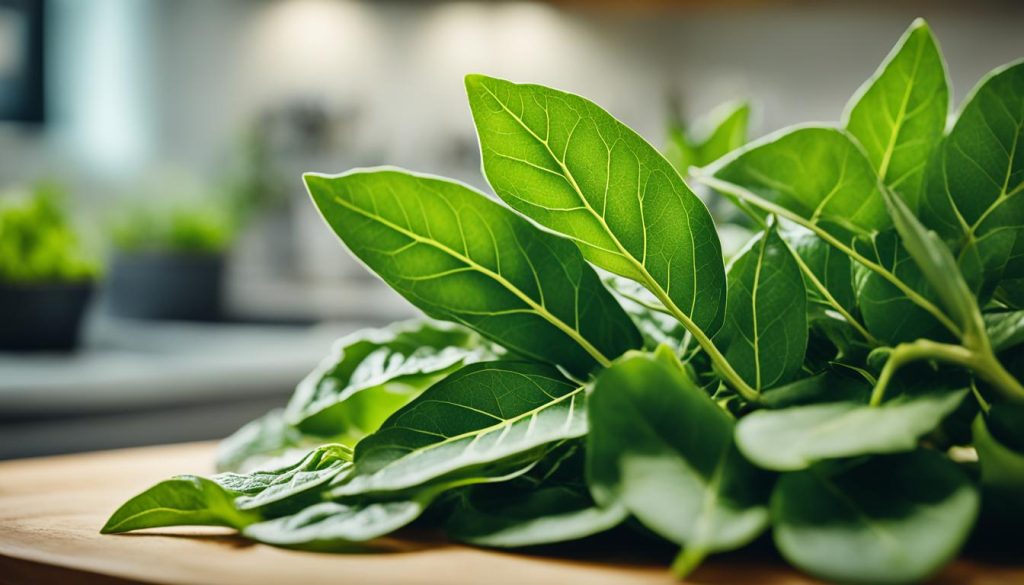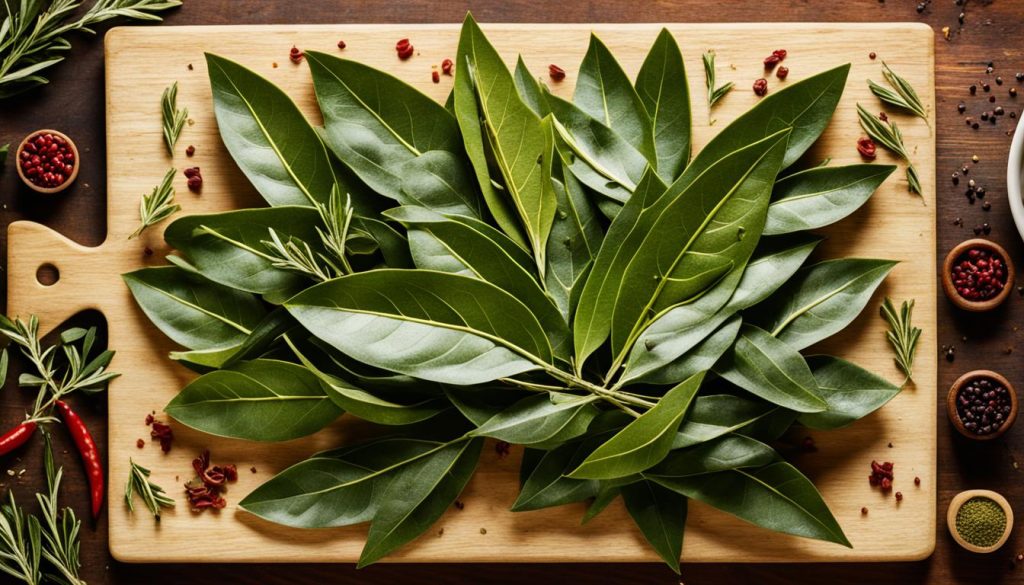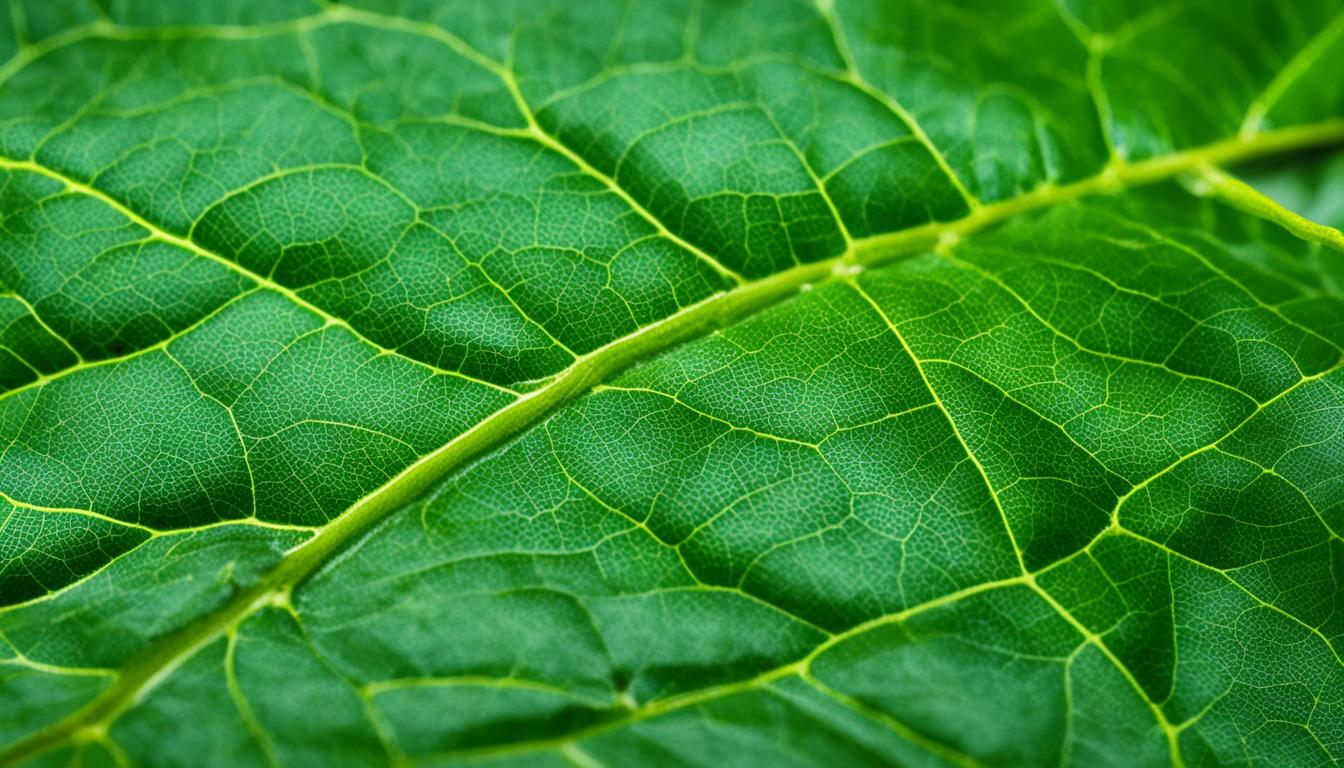I love cooking at home and I’ve learned how great bay leaves are. They might look simple, but they add so much to my food. Adding bay leaves to stews or rice makes a big difference.
Slow cooking with bay leaves takes time, but it’s worth it. The flavors get better and better, making the dish special. Skipping bay leaves means missing out on amazing flavors.
Bay leaves are good for more than just taste. They help with digestion and are full of antioxidants. I’m always finding new ways to use them in my cooking.
The Humble Bay Leaf: An Underappreciated Culinary Gem
The bay leaf is often overlooked but is a key ingredient in many kitchens. It’s debated whether it adds flavor or not. Some say it doesn’t taste much, while others believe it brings depth to dishes.
Exploring the Divisive Nature of the Bay Leaf
The bay leaf’s scent is mild, but it adds a special taste when cooked. It brings a subtle minty, peppery, and floral flavor. You should never skip this ingredient when slow cooking with bay leaves for maximum flavor.
“The bay leaf may not be the most exciting ingredient in the spice cabinet, but it’s a quiet workhorse that can truly elevate a dish when used properly.” – Chef Jamie Oliver
Unraveling the Flavor Profile: Does It Really Contribute?
Some think the bay leaf doesn’t add much to a dish, but it actually does. Its flavors can change the taste and smell of a meal. It blends well with soups, stews, and sauces, making them more complex.
If you’re unsure about the bay leaf, try it out. It can surprise you by changing your cooking for the better.

Bay Leaf: A Historical Perspective
The bay leaf has a long and interesting history. It goes back to ancient Greece and Rome. There, it was seen as a symbol of honor and victory. Bay leaves were given to winners to show their honor.
It was also known for its healing powers. The ancient Greeks and Romans used it in their medicine. This shows how important the bay leaf is in cooking and culture. And that’s why you should never skip this ingredient when you cook.
Tracing the Origins and Cultural Significance
The bay leaf comes from the Mediterranean, where the Laurus nobilis plant grows. This evergreen shrub has been used for centuries. Its leaves are loved for their smell and taste.
- In ancient Greece, bay leaves were linked to the god Apollo. They were given to winners and poets.
- In ancient Rome, bay leaves made wreaths for winners, honor, and scholars.
- Other ancient cultures, like ancient Egypt, used it in religious rites and for mummification.
This history shows how important the bay leaf is in cooking and culture. And that’s why you should never skip this ingredient when cooking.

“The bay leaf is a symbol of honor and victory, deeply rooted in the cultural heritage of ancient civilizations.”
| Ancient Culture | Bay Leaf Significance |
|---|---|
| Ancient Greece | Associated with the god Apollo, used to crown victorious athletes and poets |
| Ancient Rome | Used to create wreaths and crowns symbolizing triumph, honor, and academic achievement |
| Ancient Egypt | Used in religious ceremonies and as a preservative for mummification |
Varieties of Bay Leaves: A World of Flavors
I love exploring the world of bay leaves in my cooking. There’s more to bay leaves than just the Mediterranean type. Each type brings its own special flavor to slow-cooked dishes.
California bay leaves have a strong smell and taste. They add a deep flavor to soups and stews. Indian bay leaves taste a bit like cinnamon, making them great for rice and curries.
- Mediterranean Bay Leaf: The classic, widely-used variety with a mild, slightly menthol-like flavor.
- California Bay Leaf: Offers a more pronounced, assertive aroma and flavor profile.
- Indian Bay Leaf: Presents a delicate cinnamon-like note, perfect for aromatic dishes.
- Turkish Bay Leaf: Renowned for its intense, resinous flavor, adds complexity to slow-cooked meals.
- Mexican Bay Leaf: Brings a unique citrus-like undertone, complementing Latin American cuisine.
| Bay Leaf Variety | Origin | Flavor Profile | Culinary Applications |
|---|---|---|---|
| Mediterranean | Europe | Mild, slightly menthol-like | Soups, stews, sauces, braises |
| California | United States | Robust, assertive aroma | Hearty dishes, marinades, pickling |
| Indian | India | Delicate, cinnamon-like | Rice dishes, curries, spice blends |
| Turkish | Turkey | Intense, resinous | Slow-cooked meats, braises, stews |
| Mexican | Mexico | Citrus-like undertone | Latin American cuisine, marinades |
Trying different bay leaf types can open up new flavors in your cooking. Whether you’re making a stew or a rice dish, the right bay leaf can make it better. Try these options and find your favorite for slow cooking with bay leaves.
Bay Leaf: Culinary Applications and Techniques
I love cooking at home and use bay leaves to add flavor. These dried leaves change a dish’s taste, making it richer and more complex. They turn simple recipes into something special.
Enhancing Soups, Stews, and Sauces with Bay Leaf
Bay leaves are great in slow-cooked dishes like soups, stews, and sauces. They slowly add their flavor and aroma to the dish. This makes the food taste amazing.
Adding bay leaves to a beef stew or bolognese sauce changes everything. As it cooks, the bay leaves add a unique taste. This taste is earthy, a bit minty, and slightly citrusy. It makes the dish taste better.
“The key to unlocking the full potential of bay leaves is to allow them to gently infuse the cooking liquid over an extended period, allowing their essential oils to gradually release and permeate the dish.”
Learning to cook with bay leaves can make your cooking better. They work well in many dishes, from soups to sauces. Bay leaves are very versatile.

Bay Leaf: Unlocking Nature’s Medicine Cabinet
Beyond their use in cooking, bay leaves are now seen as a powerful health aid. They are a true treasure of natural remedies. These leaves offer many benefits that can improve our health.
Health Benefits: From Digestive Aid to Antioxidant Powerhouse
The health perks of bay leaves are amazing. They have anti-inflammatory properties. This is due to compounds like eugenol and myrcene. Adding bay leaves to your meals can help reduce inflammation. This can ease joint pain, arthritis, and some skin issues.
Bay leaves are great for your stomach too. They help make digestive enzymes. This can ease problems like indigestion, bloating, and gas. Adding them to soups and stews can soothe your stomach and help with digestion.
Bay leaves are also full of antioxidants. These can lower the risk of diseases like cancer and heart disease. Antioxidants fight off harmful free radicals. They protect our cells from damage and keep us healthy.
Incorporating bay leaves into your cooking can provide a range of health benefits, from reducing inflammation to supporting digestive health and offering antioxidant protection.
By using bay leaves, we can tap into their natural healing powers. They can help with digestion, inflammation, and overall health. Bay leaves are a great addition to any diet.

Bay Leaf: Folklore, Myths, and Symbolism
The bay leaf has a long history and is very important in many cultures. It has been a part of folklore, myths, and symbolism for a long time. People all over the world find it fascinating, making it more than just a spice.
In ancient Greece and Rome, people thought the bay leaf could keep evil spirits away. They also saw it as a sign of honor and victory. Winners of contests and important people were given bay leaf wreaths.
“The bay leaf was a symbol of honor and victory in ancient Greece and Rome, with wreaths of bay leaves used to crown victorious athletes and distinguished individuals.”
The bay leaf’s mystique comes from its deep history and importance in culture. It started in the Mediterranean and is still used today in cooking and more. This herb is interesting and useful, never to be left out when cooking.
Whether you like the bay leaf for cooking or its history, it’s a special herb. It changes dishes and has a deep cultural meaning. This shows the importance of why you should never skip this ingredient.
Bay Leaf Recipes: Elevating Flavors in the Kitchen
Slow cooking with bay leaves opens up a world of flavors in the kitchen. This simple herb can turn simple dishes into amazing meals. Let’s look at two recipes that show how bay leaves can make your food better.
Bay Leaf Chicken Stew: A Comforting Classic
A bowl of bay leaf chicken stew is the ultimate comfort food. By slow-cooking chicken with veggies and bay leaves, you get a dish full of flavor. Bay leaves add a special aroma and flavor that slow cooking brings out.
Bay Leaf Infused Rice: A Fragrant Side Dish
Make your rice better with bay leaf magic. Just add a few bay leaves to the water. This makes the rice smell great and taste subtly different. Serve it with your main dishes for a burst of flavor.
Try these recipes to see the magic of slow cooking with bay leaves. You’ll find new ways to use this simple herb. Let bay leaves take your cooking to the next level.
Bay Leaf: Aroma and Essence in a Cup
The humble bay leaf is more than just for savory dishes. Enjoy it as a soothing tea. Steep dried bay leaves in hot water to get their essential oils. This tea tastes like mint and smells great. It can help with digestion and calm you down thanks to linalool.
Drinking bay leaf tea is a great way to enjoy this herb. It’s perfect for relaxing or exploring its unique taste. A cup of bay leaf tea will make you feel good and keep you healthy.
Unlocking the Benefits of Bay Leaf Tea
- Aids digestion: Bay leaves can ease stomach troubles like bloating and constipation.
- Provides a calming effect: Linalool in bay leaves helps you relax and reduce stress.
- Boosts immunity: Bay leaves are full of antioxidants that fight off illness and stress.
- Supports heart health: Drinking bay leaf tea might lower cholesterol and blood pressure, helping your heart.
Bay leaf tea is a simple, yet powerful way to experience the aromatic and therapeutic potential of this unassuming herb.”
Looking to relax, improve your digestion, or enjoy bay leaves’ unique taste? A warm cup of bay leaf tea is perfect. Next time you’re in the kitchen, try using a few bay leaves. Discover the health benefits of bay leaf in a cup.
Bay Leaf: A Versatile Ingredient for Every Cuisine
The bay leaf is a key ingredient in many cuisines worldwide. It goes from French béchamel sauce to Indian curries. Bay leaves add a special touch to many dishes.
Adding bay leaves to stews, meats, or pickles makes them better. It brings a subtle depth of flavor. Why you should never skip this ingredient – using bay leaves in slow cooking changes the game. Plus, they’re good for you.
Bay leaves add aroma and flavor to dishes. They make my cooking better. By using them, I can impress my guests with tasty dishes.

